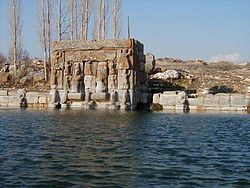- Eflatun Pınar
-
Eflatun Pınar (Turkish: Eflatunpınar, "lilac-colored spring") is the name given to a spring which rises up from the ground, creating an oasis and fountain. The spring lies 80 miles west of Konya, and drains into Lake Beyşehir in Anatolian peninsula at ancient Pisidia region. In ancient times a small temple was built here to honor one of the ancient Hittite gods, and later Plato was confusely credited with the spring. The shrine precedes Plato of about 1000 years [c.1300 BC]. Eflatun Pinar is the modern name for the location.
The region corresponded to Pisidia in Classical Antiquity.
Eflatun Pınar's location near the lake shore corresponds to an almost exact level with other important ruins on the opposite shore, those of Kubadabad Palace, which are Seljuk.
Eflatun Pınar was briefly examined by the University of Oxford archaeologist Dr. Lucia Nixon in her paper on Çatalhöyük, and she makes use of F.W.Hasluck's early-20th century work. The site remains largely unexplored to date.
References
- Dr. Lucia Nixon, University of Oxford (2001). "Eflatunpınar, Çatalhöyük and the uses of the past (Conference on Anthropology, Archaeology and Heritage in the Balkans and Anatolia)". Swansea University. http://www.swansea.ac.uk/cssee/pdfs/spkrs3.pdf.
External links
- [1] (Pdf file) Anthropology, Archaeology and Heritage in the Balkans and Anatolia
- [2] Views of Eflatunpinar Hittite Spring Temple & Dam.
Coordinates: 37°49′32″N 31°40′29″E / 37.825666666667°N 31.674694444444°E
Wikimedia Foundation. 2010.

